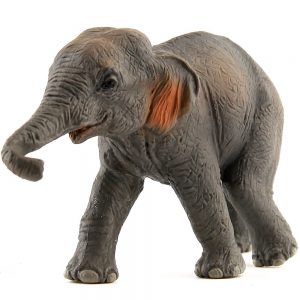Asian Elephant
Category : Majestic Elephants

Wildlife Collection – Baby Asian Elephant Beautifully Hand Painted Figure
Asian elephants are the continent’s largest terrestrial mammals. They can reach 6.4m in length and 3m at the shoulder, and weigh as much as 5 tonnes.
They are smaller than African elephants and have proportionally smaller ears, which they keep in constant motion in order to cool themselves. They also have a single ‘finger’ on the upper lip of their trunks as opposed to African elephants, which have a second one on the lower tip.
Their skin ranges from dark grey to brown, with patches of pink on the forehead, the ears, the base of the trunk and the chest.
A significant number of male Asian elephants are tuskless. The percentage of males with ivory varies from just 5% in Sri Lanka to aound 90% in southern India – possibly reflecting the intensity of past ivory hunting.
There are three subspecies of Asian elephant – the Indian, Sumatran and Sri Lankan. The Indian has the widest range and accounts for the majority of the remaining elephants on the continent. The Sri Lankan is physically the largest of the subspecies, and also the darkest in colour. The Sumatran is the smallest.
Asian elephants are extremely sociable, forming groups of six to seven related females that are led by the oldest female, the matriarch. Like African elephants, these groups occasionally join others to form herds, although these associations are relatively transient.
Asian elephant skin is gray in color. Some parts of their skin sometimes lack color, especially on and around the ears, forehead and trunk. This de-pigmentation is believed to be controlled by genetics, nutrition and habitat, and generally develops as the elephant ages. Brownish to reddish hair covers the bodies of young elephants. The amount of hair reduces with age, and the color darkens.
Asian elephants have one small projection at the end of their trunk called a “finger,” which aids with precision. Elephants use their trunks to take up water and squirt it into their mouths. The trunk is capable of performing many other functions as well, including: feeding, snorkeling, dusting, smelling, sifting, sorting, touching, sound production/communication, lifting, pushing, defense and offense. It can hold about 2 gallons (7.57 liters) of water. With their trunks, elephants “know” their world: their senses of smell and touch being very important.
Asian elephants are found in isolated pockets of India and Southeast Asia, including Sumatra and Borneo. Asian elephants were formerly widely distributed south of the Himalayas, throughout Southeast Asia and in China as far north as the Yangtze River.
Asian elephants are considered forest animals; however, they have been observed to prefer zones that include intermittent open grassy glades. These zones contain transition areas with a great variety of species of plants between grass and forest, not available in dense woodlands. These zones also provide quick escape from the sun. Elephants are adaptable and can live in a variety of environments.
Asian elephants are herbivores. An elephant spends about three-quarters of each day eating or moving toward a food or water source. Feeding is not continuous, with three principal feeding bouts in the early morning, afternoon and night.
Elephants tend to rest and nap during the hottest hours of the day. They feed primarily on grasses, but also consume large amounts of browse: leaves, roots, vines, twigs, shoots and bark as well as fruit. Cultivated crops such as bananas and sugar cane are also a favored food. Foraging herds can be very destructive to cropland or forest because they are capable of pushing down large trees in order to gather their foliage and bark.
The longevity record for an Asian elephant in captivity is 86 years. There is not enough consistent data available on wild Asian elephants to accurately estimate their life span; however, it is thought that Asian elephants typically live into their mid- to late 50s.
If you have any information,questions, or feedback you would like to include in this post.
Please email momo19@naturekingdoms.com or leave your comments below.